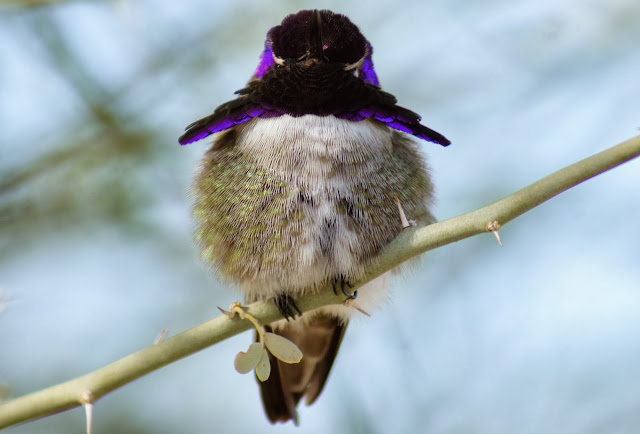Himmell Park was our first stop. We left Phoenix at 5:00 A.M., and arrived at Tucson and the park before it really got light out. After stopping at McDonald's to eat and kill time, we went back to the Himmel Park in search of the Harris's Sparrow. Once parking, we walked a short distance across the park to where the Harris's Sparrow was being seen. As we came upon the location, I heard a sparrow calling that sounding like a call of a Zonotricia sparrow. When I looked up on the tree where the sound was coming from, it was none other than the Harris's Sparrow!
We found this continuing rarity within the snap-of-a-second, and it was a nice lifer for both of us! The Harris's Sparrow is one of the largest sparrows in North America, and it is one that I have been wanting to see for awhile. This sparrow is rare but usually annual in Arizona. The other rarer members of the Zonotricia genus, the Golden-crowned and White-throated Sparrows, are found more often. This Harris's Sparrow gave us great views for about 30 minutes before we moved onto our next stop.
After the Harris's excitement, we then headed to Florida Canyon in hopes of seeing Rufous-capped Warblers. This beautiful canyon is always fun to visit.
On our way in, we were greeted by a Pyrrhuloxia!
Once above the dam, we started to search for the Rufous-capped Warblers in their usual haunts. Having seen this species only once in my life before, I was dying to see another one. Four of them were reported, and I felt like our stakes were high for seeing them. These rare Mexican warblers have bred in this canyon, and are very reliable here in Florida. Many travel to this location hoping to get lucky with this neat bird. It didn't take Moe and I long, and as a turned a corner, the Rufous-capped Warbler was foraging in a bush only a few feet from me!
Moe was shortly behind me, and I quickly called him over to get looks at this spectacular bird. This quickly turned into one of my very favorite highlights of 2013!
Fellow birder Chris McCreedy referred to the Rufous-capped Warbler as being, "beastly cute". I think McCreedy has a strong point there. As Moe and I continued to snap photos and watch the birds, the warbler continued to forage. We didn't even need binoculars.
The Warbler then decided to move and forage directly underneath us..
When a Rufous-capped Warbler finds Arizona, it favors habitats similar to Florida Canyon, which are streamside vegetation in medium elevations between 4 and 5,000 feet. What a neat bird to see on the last day of the year, or just anytime in general!
The Warbler started calling actively and we heard another singing nearby, which was the first time I have heard the song of this species live when in the field. It was amazing! I then spied a previously reported male Elegant Trogon in the canyon, who we were able to get brief looks at. The Rufous-capped Warblers were amazing, clearly the main highlight of our day. And here is Moe enjoying the canyon and celebrating his first ever Rufous-capped Warbler!
After Florida Canyon, we decided to head down to the Santa Cruz Flats after passing up on Tubac to look for Mountain Plovers and Crested Caracaras. We saw a distant flock of Mountain Plovers, and had great looks at the Caracaras. We counted at least 20 Crested Caracaras, which was a lifer for Moe and was only my 3rd time ever of seeing one. It was very neat to observe them in numbers and have extended views. Several tractors were plowing the fields and were being chased by eager and hungry Caracaras.
The Crested Caracaras and Santa Cruz Flats were my final birds and birding location of an epic 2013. By the end of the day, I had one lifer and Moe had 7 lifers to conclude an excellent birding day. Thank you Moe for the fun day and company!
I ended my Arizona list with 377 species, my personal best list for a year in Arizona. It was overall my best year of birding yet, stay tuned for an extensive recap of the year with summaries of birds, trips, lifers, and more! What will 2014 bring? What will be my first bird next year? How about my first lifebird? Will any new state records be discovered by a lucky birder? Its going to be exciting. But I will never forget my Arizona birding year of 2013.
Happy New Years! In 20 minutes and counting.............





































































